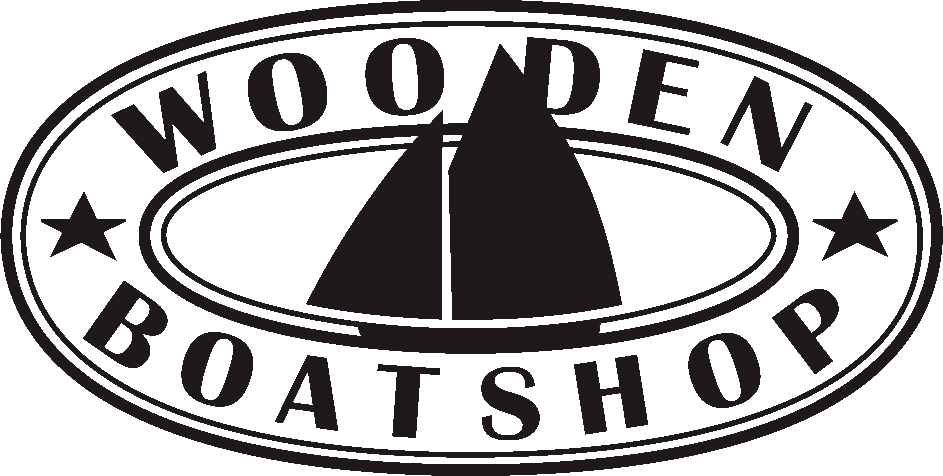Pisces Restoration
Follow along as we restore the 46’ shark fishing boat Pisces.
As we reach milestones in the build, we’ll upload a new episode detailing how
we do what we do. Below you’ll find a short history of the vessel from its launch
in Mordialloc by Jack Pompei in 1977.
History

Heritage
An iconic boat
Built in 1977 by renowned local boatbuilder Jack Pompei, Pisces is a 46’ shark fishing boat. Our restoration plans (see below) have been informed by legendary boatbuilder and designer Ken Lacco. Pisces is largely considered by many to be a sister ship to the Ken Lacco designed, Garry Stewart built Jane Kerr. Jane Kerr is just 2’ longer than Pisces and was built as a crayfishing boat for Garry Kerr in Portland in 1981.
Pisces was famously involved in a collision with the bulk carrier Iron Prince off Port Nelson in 1995. While she sustained damage from the 539’ ship, she did not sink and was escorted into the Portland area for repairs.

A true blue fishing boat...
From her early days Pisces worked from Apollo Bay, venturing into Bass Strait for shark fishing and netting. After a stint at a few other Victorian west coast ports, she was eventually taken to Queensland where she was used as a vessel for fishing the black tipped reef shark.
A few years ago, Tim Phillips, director of The Wooden Boatshop was aboard Jane Kerr in Bowen, North Queensland, when he sighted Pisces underway. Following a rigorous inspection of the boat, and enquiry with the current owner, it came to be understood that Pisces was languishing on her mooring, with the intent that she eventually sink.
From her early days Pisces worked from Apollo Bay, venturing into Bass Strait for shark fishing and netting. After a stint at a few other Victorian west coast ports, she was eventually taken to Queensland where she was used as a vessel for fishing the black tipped reef shark.
A few years ago, Tim Phillips, director of The Wooden Boatshop was aboard Jane Kerr in Bowen, North Queensland, when he sighted Pisces underway. Following a rigorous inspection of the boat, and enquiry with the current owner, it came to be understood that Pisces was languishing on her mooring, with the intent that she eventually sink.

An incredible discovery
Tim arranged to purchase the boat, and have her slipped and trucked to Victoria, where she currently resides. We have since found a new owner for Pisces who is passionate about restoring her authentically. Our plans include improvements and updates to create a perfect blend of modern technology and comfort, with traditional beauty and style.
Tim arranged to purchase the boat, and have her slipped and trucked to Victoria, where she currently resides. We have since found a new owner for Pisces who is passionate about restoring her authentically. Our plans include improvements and updates to create a perfect blend of modern technology and comfort, with traditional beauty and style.


Specifications
Length 47’
Beam 16’1”
Draft 5’5”
Power John Deere 6068T
Sail Area 655 sqf
Berths 10
Displacement Mass 25.3 tons
Beam 16’1”
Draft 5’5”
Power John Deere 6068T
Sail Area 655 sqf
Berths 10
Displacement Mass 25.3 tons
Launch of Pisces in 1977







The restoration of Storm Bay
The ten-year restoration of Storm Bay took place at The Wooden Boatshop in Sorrento.
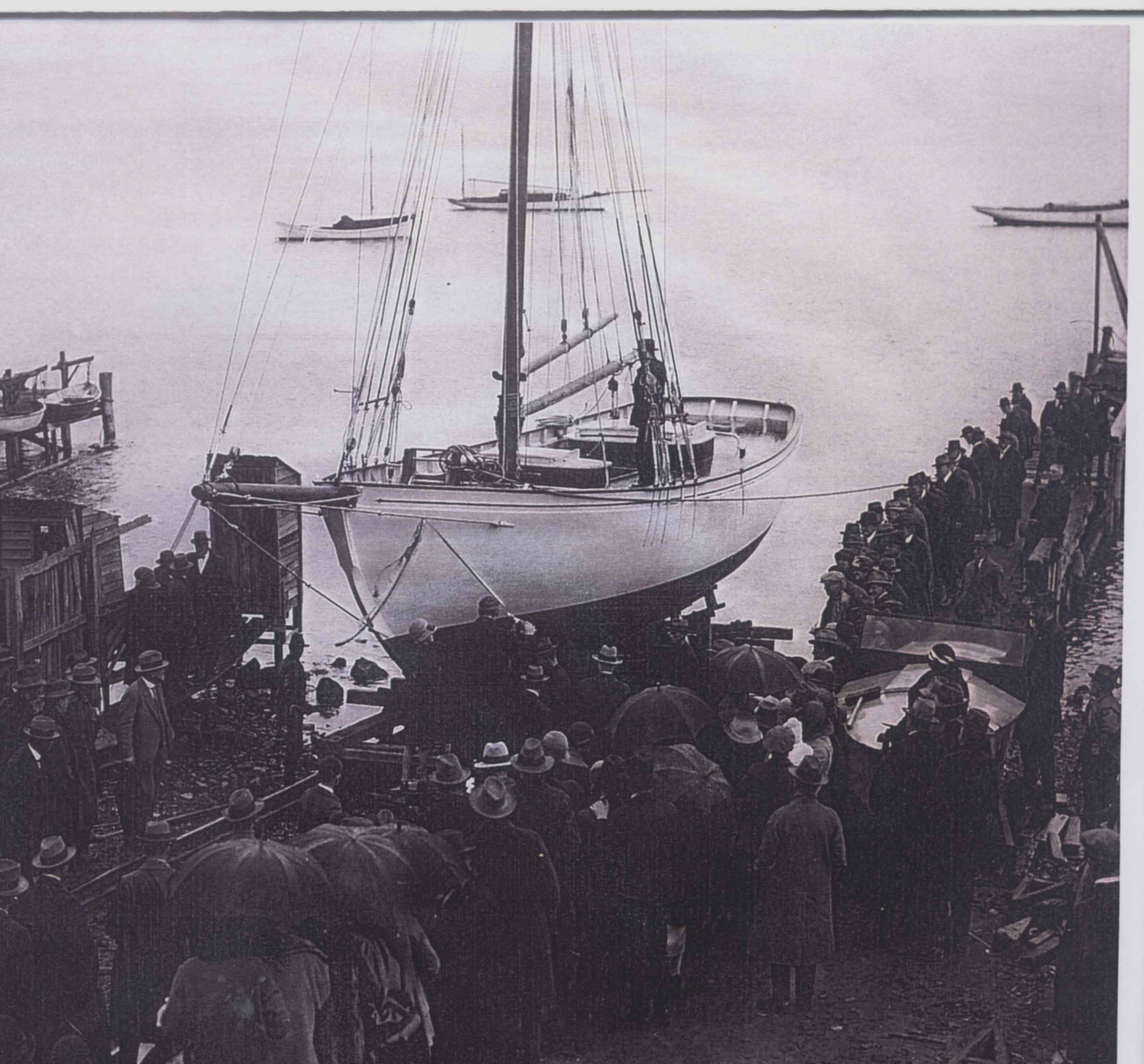
Overview
Originally designed by Alfred Blore, Storm Bay was built by renowned Tasmanian shipwright Percy Coverdale in his yard at Nubeena, south of Hobart. George Bridge, the patriarch of a well-known family and third-generation fisherman working from Hobart commissioned her design and build.
She was launched in Hobart in July 1925.

Named for a small inlet in the Tasman Sea, which indents southeastern Tasmania, Storm Bay is about 16 miles long and 25 miles wide and is bounded by Bruny Island and the Tasman Peninsula .
George Bridge ultimately named his boat after the area he spent his life fishing.

Of her launch The Mercury reported:
“…Storm Bay is a very handsome addition to the Tasmanian fishing fleet. Looking at the smack as she stands at present she resembles a cruising yacht rather than a fishing vessel – her lines are graceful and she should prove to be speedy under sail.”
![]()
Purpose-built Storm Bay was George’s last boat and built at a time when the Tasmanian fishing industry was at its peak. The Bridges’ worked and immaculately maintained Storm Bay until 1963. Storm Bay was their pride and joy.
Jim Bridge recalls:
“It was not an easy job using such a lovely boat as a working fishing boat but George insisted that she be well cared for during this period of her life... especially with her yachting lines when speed did not help a well full of fish or heavy wash across her decks would quickly remove dinghy, nets, and sundry fishing gear quite quickly!!”
“…Storm Bay is a very handsome addition to the Tasmanian fishing fleet. Looking at the smack as she stands at present she resembles a cruising yacht rather than a fishing vessel – her lines are graceful and she should prove to be speedy under sail.”
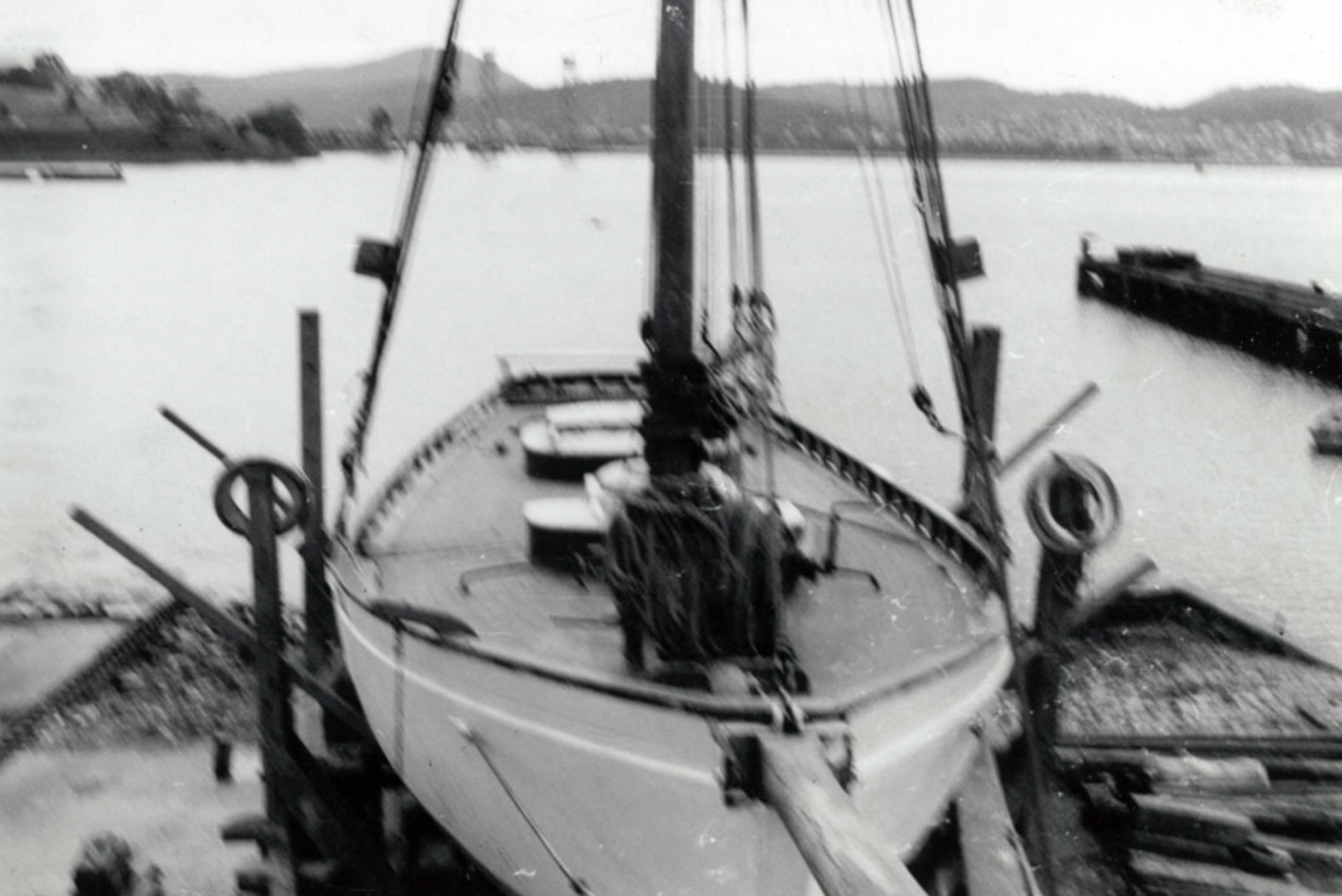
Purpose-built Storm Bay was George’s last boat and built at a time when the Tasmanian fishing industry was at its peak. The Bridges’ worked and immaculately maintained Storm Bay until 1963. Storm Bay was their pride and joy.
Jim Bridge recalls:
“It was not an easy job using such a lovely boat as a working fishing boat but George insisted that she be well cared for during this period of her life... especially with her yachting lines when speed did not help a well full of fish or heavy wash across her decks would quickly remove dinghy, nets, and sundry fishing gear quite quickly!!”

The Bridge Family on board Storm Bay
.

The Bridge Family retail operation on Constitution Dock in Hobart.
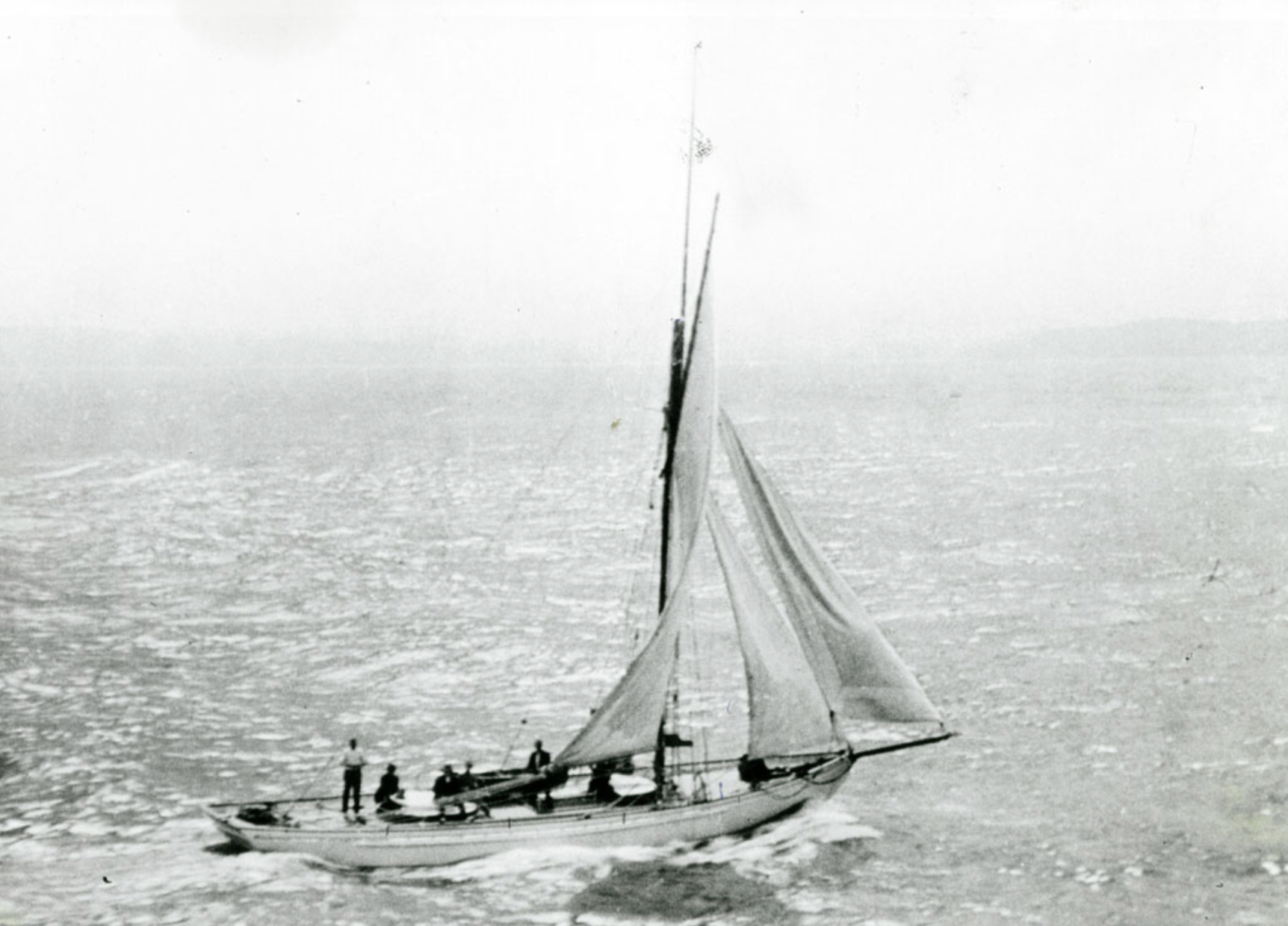
Photograph of Storm Bay as viewed by S.S. Zealandia.

A dramatic painting of Storm Bay with S.S. Zealandia by S.I. Marchant.
Footage of Storm Bay fishing under sail for barracouta in 1929, in the Storm Bay area. Barracouta are caught and landed on the deck of the boat using a jig attached to a pole. Fish are cleaned and filleted and the waste thrown overboard. Footage courtesy of National Film and Sound Archive Australia.

Portrait of Percy Coverdale.
Winston Churchill, a boat built by Percy Coverdale in 1942 was near identical to Storm Bay (6” less beam, identical hull shape but without the centreboard through the wet well and with a lead keel). Winston Churchill was pichned in a bit at the stern because Percy didn’t like Storm Bay’s wide stern, which was designed for two men to stand abrest a pole barracouta from.

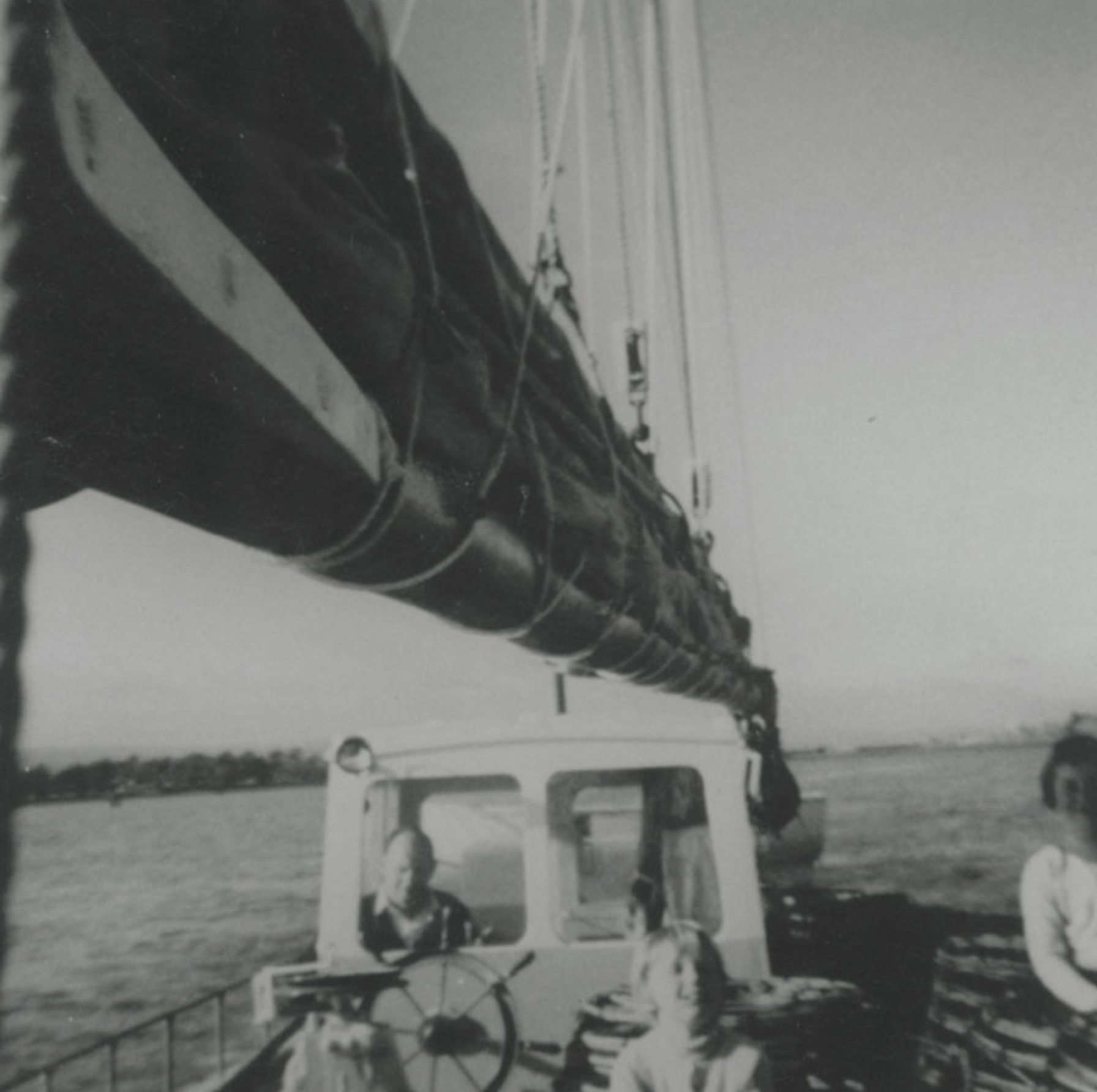
Winston Churchill begun her life by serving as a lighthouse tender to Southern Tasmania. She was skippered by Percy in the very first 1945 Sydney-Hobart Ocean Race and placed 2nd overall.
Contrary to her working-sister Storm Bay she spent her life operating as a yacht and competing in ocean races around the world. Twice she circumnavigated the globe and all up she competed in 17 Sydney-Hobarts.
Sadly, the infamous 1998 Sydney-Hobart was her last race, she was wrecked with three of her crew-members tragically drowned. This made the preservation and restoration of Storm Bay ever more important, less her design and build be lost at sea or the annals of maritime history.

Through a succession of three different owners from 1965 to mid-1980s Storm Bay worked out of St. Helens in northeastern Tasmania as a cray fishing boat, she also had a stint serving abalone divers, and even had a scallop dredge on her stern for a time. Along the way she aquired a wheelhouse, had her topmast set down and generally had her rig reduced.

By 1996 she was all but completely delapidated and had returned to the piers at Constitution Dock in Hobart, albeit in an entirely different condition to her early years.


Tim’s first sight of Storm Bay.

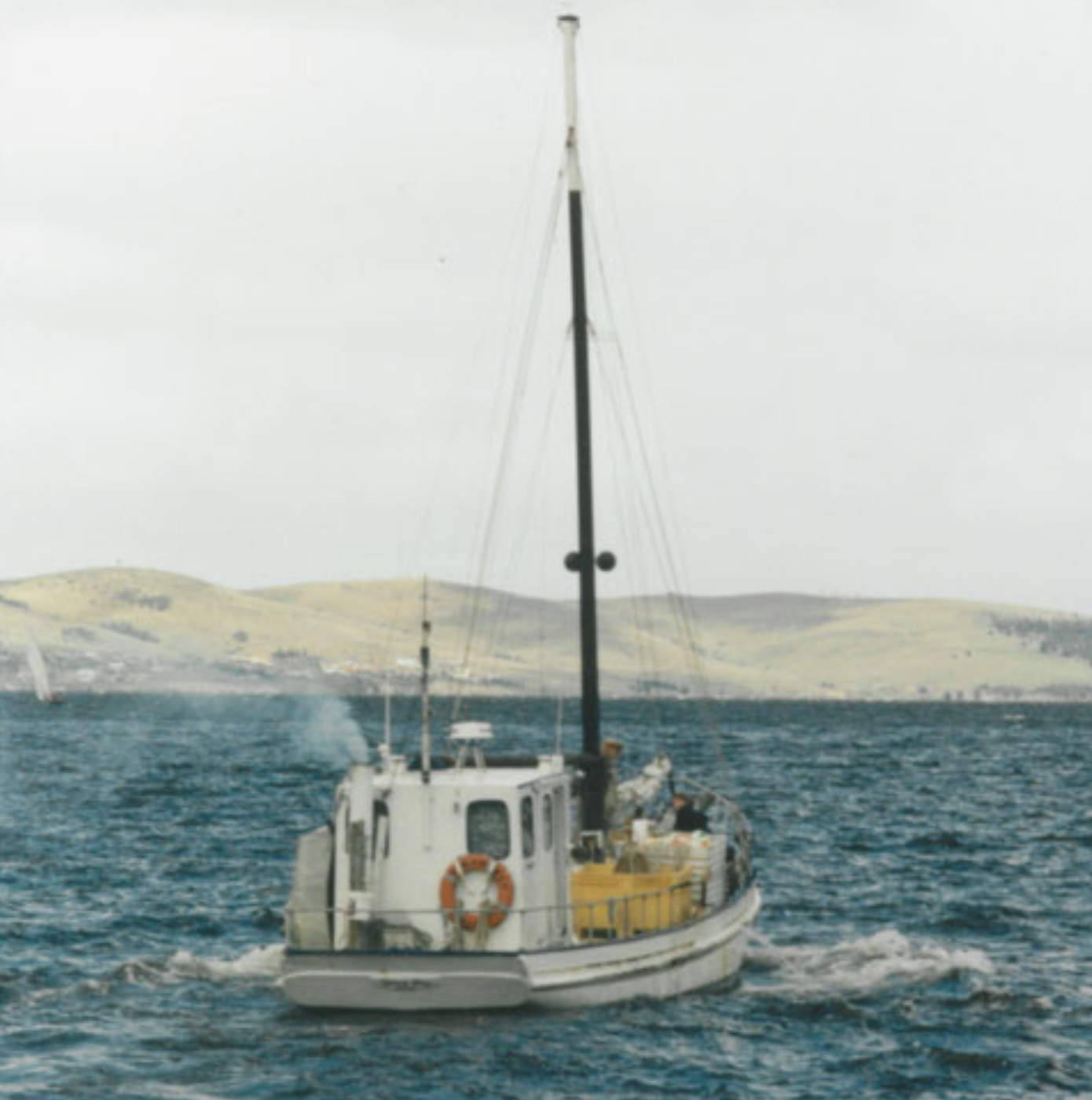
Bringing Storm Bay to The Wooden Boatshop in Sorrento, Victoria.



Haul out and arrival at The Wooden Boatshop.

Stripping Storm Bay back to basics in order to begin restoration to original set-up and condition.


Photos of rigging set-ups from similar boats helped in planning the restoration.


Cassilda Pin Rail.

Storm Bay line plans.

Fixing the hull... replacment of stern post and stem.


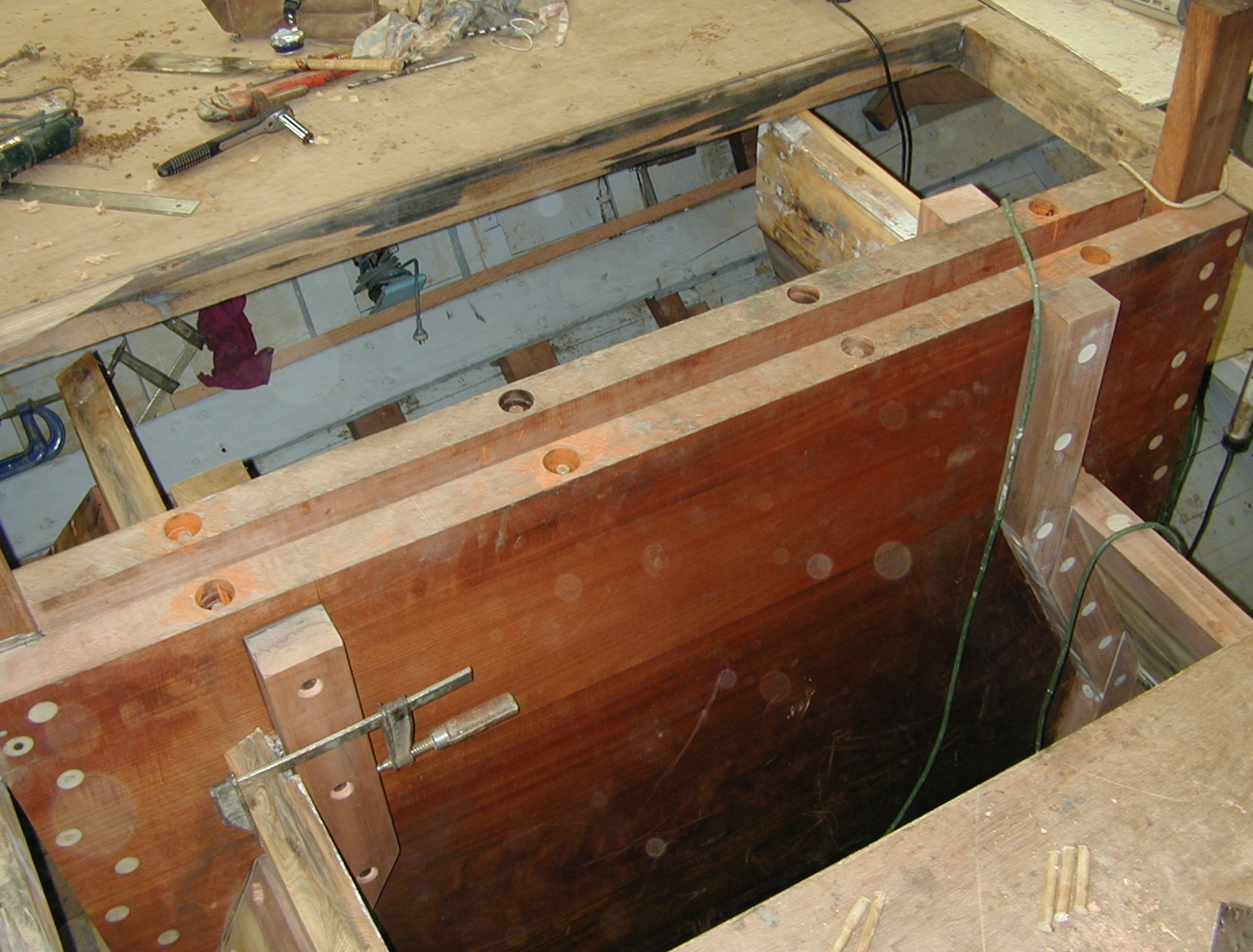
Rebuilding the wet well.

Laying the deck.

Interior layout.

Launch.


Storm Bay dinghy in the early days.



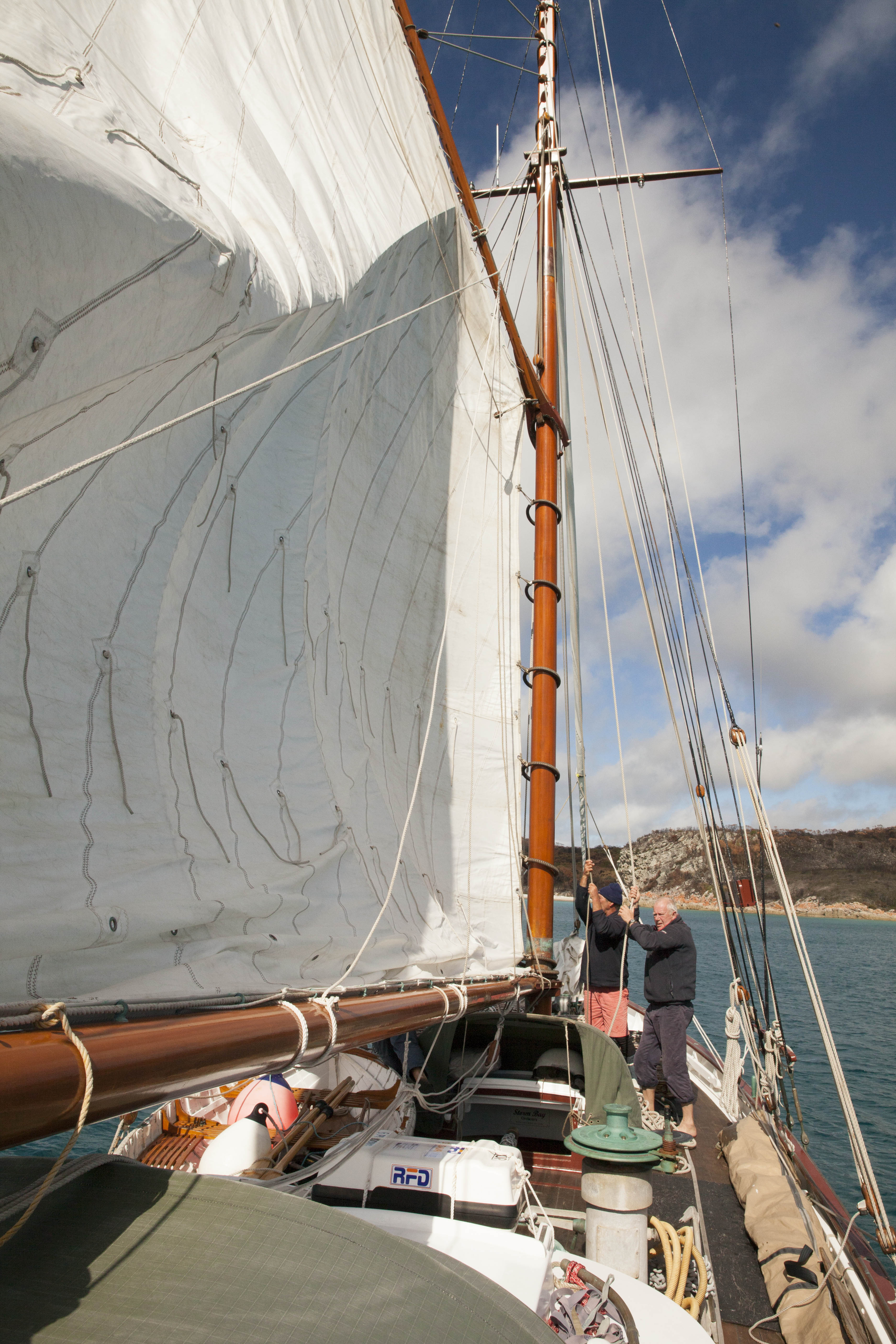








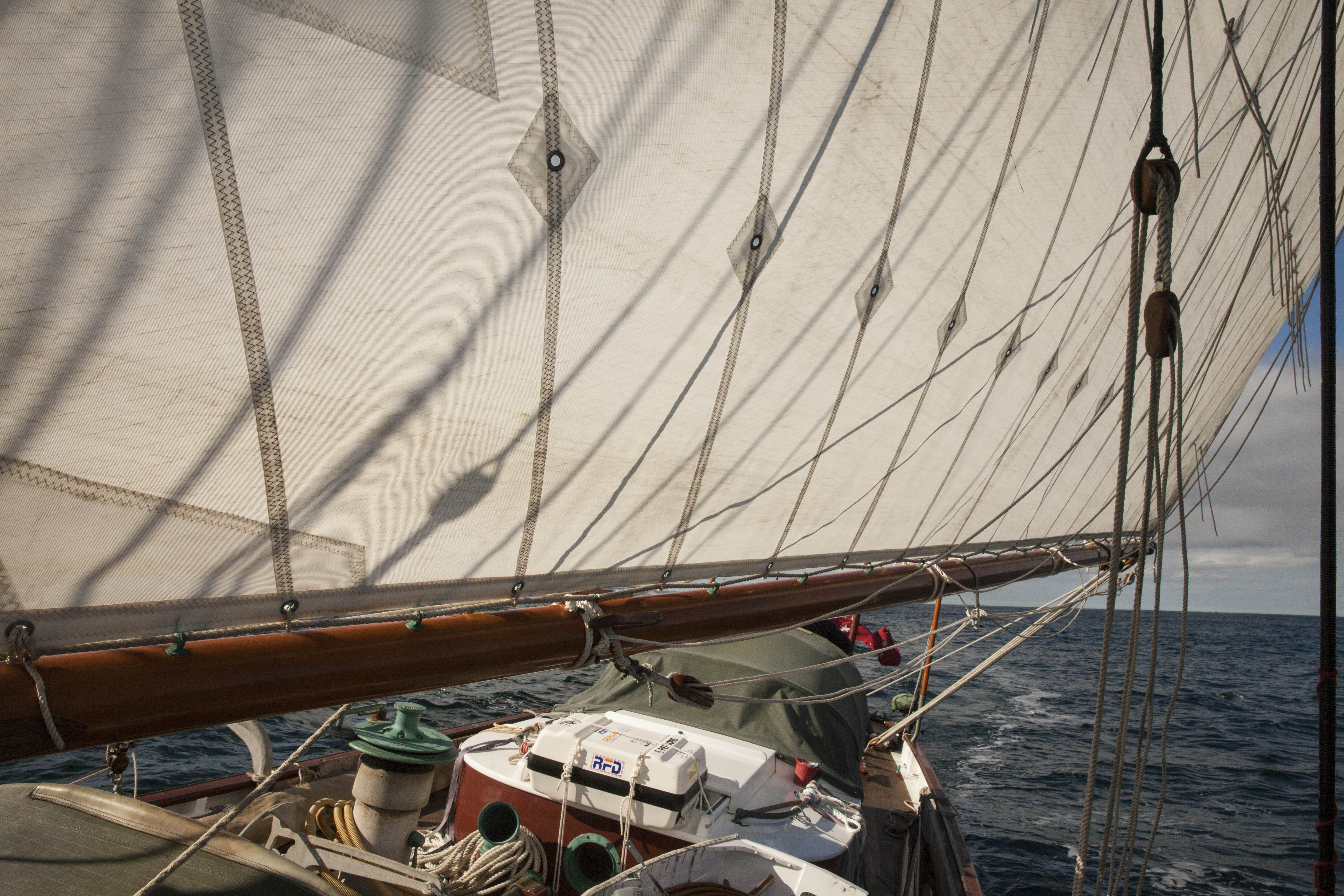



Yeulba
Logan 30’ Lineal Rater 1901
“In the first half of the 20th century the magnificent topsail cutter Yeulba was, far and away, the most famous racing yacht in Australia. Under a succession of high profile owners including the Governor General, Lord Forster and the Governor of Victoria, Lord Stradbroke, she won all the major trophies and remained for many years unbeatable.”
BRUCE STANNARD
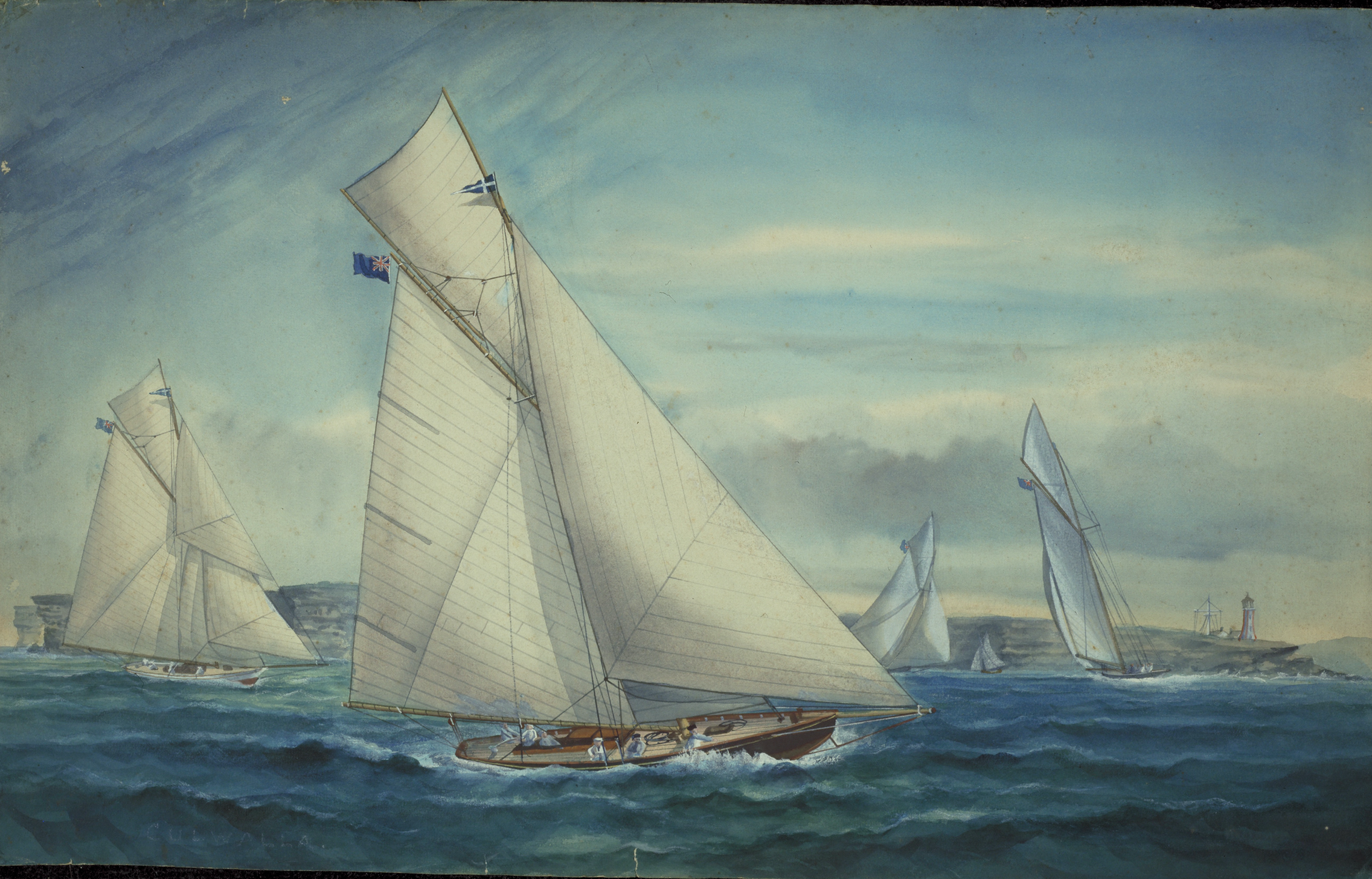
Introduction
Recalling my first sight of Yeulba I saw a truck arrive at The Wooden Boatshop with a gracious long, slender yacht hull loaded on a trailer, down in condition, with an indignant 1970s cabin and big spade rudder added onto her. Just as a face shows age and character, Yeulba intrigues in the same way. She’s interesting to look at, and my word, does the old girl have a story to tell.
She is a fine example of a Logan yacht. Regarded by many as the best of her type and is coming up to 120 years of age. When you delve into her illustrious past, her owners, miles under her keel, feet across her decks and wind through her sails, that the real story begins to unfold. A yachting narrative, mostly forgotten, unwritten and destined to lay buried in archives and dusty old books, until now.
I began with an internet search, to try and find out more of Yeulba’s history. What is a Lineal Rater? What do the words Yeulba and Culwulla mean? Who were Walter Marks and Lord Forster? My first great discovery was the G.F. Gregory painting (above), an image which evokes the spirit of Yeulba. Further searching on the National Library website revealed an overwhelming response of newspaper articles, that unveil a unique perspective of yachting through the ages, told by Yeulba herself. Linking generations, and a champion of four states, Yeulba, you could say is a bit of a Pharlap-type hero — a legend of boats!
With Yeulba we have the opportunity to continue a journey from the past. To save important links that are so often lost with the passing of each generation. Under the plywood, fibreglass and stainless steel she is still very much alive. Her prize New Zealand Kauri planking and mysterious eye catching hull remain true to form and origin. Yeulba is ready to open another chapter and take you on a journey. Salvation for this near forgotton treasure, and a sailing adventure of a lifetime, worthy of the history books, is what we have to offer.
In scratching the surface of her past, a picture of Yeulba’s significance develops and it becomes clear that we are dealing with a national treasure. Her wider connections to yachting, the evolution of sailing as a sport is no doubt worthy of a book. I say with confidence that she should moor alongside Australia II and certainly ranks in significance above any other yacht still in existence from our yachting hall of fame.
We are searching for someone to assist us in finding a syndicate or individual to throw Yeulba a hawser and enable a restoration true to her 1901 configuration and finish. An outcome that will give her new owners a beautiful yacht of distinction, unique and practical, ready for shipping, competing locally and worldwide in any of the world’s prestigious classic yacht regattas.
WAYNE PARR
Shipwright, General Manager
The Wooden Boatshop

Highlights from the life of the yacht Yeulba

Walter Marks
In 1901 Walter Marks ordered Yeulba from the Logan yard during a period of growing popularity of the 30’ lineal rater class that had developed on Sydney Harbour. Originally named Culwulla, she was to be the champion of the 30 footers of the first season. The winning results and commentaries of the races are well documented in newspapers of the time, including twice winning the 20 Footers Pennant and the highly coveted Gascoigne Cup.
Whilst leading a race, on the 27th of January 1902, Yeulba was suddenly run into by the small steamer Agenoria. The result of this collision was damages to the starboard side of Yeulba, claimed by Marks to be the sum of 230 pounds. A court case began with the result of Mr Marks being awarded the sum of 80 pounds. The repair work of this damage can still be seen today.
Walter Marks was a member of Parliament for a period of 12 years, and his chambers, Culwulla Towers, are credited as being the first high-rise building in Sydney. Often referred to as the Thomas Lipton of Australia, he was invited to sail aboard Shamrock IV in the 1914 America’s Cup. With the advent of World War I the Cup was postponed and Marks’ subsequently did not compete. However, he went on to own a further three yachts, carrying the Culwulla name forward with great success, winning many more prestigious trophies.


Two More Owners of Distinction
In 1909, Marks sold the yacht to Mr A. Mullins, who renamed her Yeulba, and she continued to be successful in her first season under new ownership, winning another Gascoigne Cup. During the 1911-1912 season, Yeulba won a number of trophies including the prestigious Basin Cup, a 60-mile ocean race from Sydney to Broken Bay (around Lion Island) and return. In later years Yeulba won the Rawhiti, Albert and Sir Rupert Clarke Cups.
Later, Mr Frederick J. Doran, General Manager of the Port Jackson Manly Ferry Company acquired her. He was quite a skipper, owning a fleet of boats, including three Logan yachts; Mercia a very successful 1st Rater, Sunbeam in which he won the Commonwealth regatta, and Yeulba. He was also a casual skipper of Walter Dendy’s Sea Rover (a Jones built Couta Boat), competitor in the 18 Footers and 21’ Restricted Class Yachts.
Our Sailing Governor General
Lord Forster was Governor General of Australia from 1920 to 1925. He was noted to be popular with the people and an excellent all round sportsman. He played cricket for England in 1893 against the Australian 11, he was also fencing and tennis champion of Oxford.
As soon as Forster arrived in Australia, he was elected Commodore of the Royal Sydney Yacht Squadron and the Royal Yacht Club of Victoria. He soon had Yeulba shipped to Melbourne, where he raced her around Port Phillip with mentions at all the major clubs of the day, and won many events including the premier event, of Victoria’s Association Cup.
Lord Forster was instrumental to the development of the 21-Footer Class, of which he was a keen competitor and champion with his own boat Corella. His donation of the Forster Cup became a prestigious national yachting prize.


Built by Mr J.A. Smith this beautiful scale model of Yeulba was presented to Lord Forster at the Brighton Yacht Club. The metal fittings on the model were made from parts of the HMAS Australia which was being broken up at the time.
The model now resides in the home of Lord Forster’s grandson Mr Bill Pease, who once visited the The Wooden Boatshop on a trip from London, arriving in a big limousine, to inspect his grandfather’s yacht.

Lord Stradbroke
Lord Stradbroke, the Governor of Victoria, purchased Yeulba from Lord Forster in 1925. A noteworthy performance was winning the 1926 Geelong Regatta. Reported on the 2nd of February 1926 in the Argus newspaper, the Geelong Regatta was a great spectacle, with the yacht club using the warship HMAS Marguerite as flagship for the event.
Voyage to Tasmania
In November 1926, Yeulba embarked on a voyage to Hobart after she was
purchased by a prominent Tasmanian yachtsman, Mr E. H. Webster.
The voyage from Melbourne took 8 days. A fantastic description of the voy-
age was published in the Mercury newspaper on the 10th of December 1926:
“The seas now started to break over the counter and the starboard quarter, and
before we had gone very far the helmsman (E. Tolman) was knocked flat into
the cockpit and the skipper was washed almost overboard to leeward and then thrown down the cabin.”

Angus “The King” Cumming
Upon arrival in Hobart Yeulba was purchased by Angus “The King” Cumming. To quote the Mercury newspaper: “From a racing point of view there is at present nothing in Hobart to touch Yeulba, and she will open her career there as scratch boat of the first-class yachts.”
King Cumming went on to win many races in Yeulba, including the Hobart Regatta twice. She always cracked a mention in the papers of the day on each outing. In a race around the buoys, Yeulba demoralised the brand-new Sparkman and Stevens designed, Percy Coverdale built Landfall. An argument arose over the fact that Landfall was designed for racing in the ocean. A wager of 10 pounds was set and a race around Maria Island scheduled for Christmas day. Yeulba smashed Landfall by a whopping 4 hours. In 1931 at the Woodbridge regatta a new system of handicapping was introduced, for the first time in Australia, used today as the percentage system. Yeulba was the scratch boat.
1947-2010
Yeulba was sold to Neil McAllister in 1947 and sailed to Geelong. The first voyage was abandoned with the yacht returning to Triabunna, however Yeulba made an exceptional passage back to Geelong. It was in Geelong that Yeulba was rose upon about 8”. After another impressive racing record on Port Phillip Bay, McAllister sold her to Western Australia where she also made a name for herself, becoming champion of many races, including multiple entries in the Naturaliste Ocean race and later a familiar sight racing on the Swan River. Her Perth owners were, Mr A. R. Allom, Mr E. N. Lillingston and Mr J. McShane. John Longley of America’s Cup fame remembers well his first ocean race, during a frightening Cape Naturaliste run aboard Yeulba.



The Lineal Yacht Design Race
The late 1800s saw rapid technical advances in yacht design, in 1892 G.L. Watson designed Britannia for King George V. It was a radical departure from conventional yacht design. She had a cut away spoon bow and hard bilges, opposed to the clipper bow, slack bilged cutters of the 1800s. These revolutionary changes shocked the yachting community, but the success of Britannia and others like her, changed yacht design forever.
 Waitangi
WaitangiWaitangi of 1894 is an example of the pre-Britannia period. She was restored in Victoria in the 1990s and has since been sold and returned to New Zealand.
 Heather
Heather Heather of 1900, sister to Yeulba shows the cutaway spoon bow and flat floors of the next generation yacht. She had a long sailing career in Australia but was unfortunatly wrecked in Mornington, Victoria.
Dishy over-rigged boats of light construction began to dominate the yachting scene. The linear rule was introduced in the 1890s to formulate a rating for boats that was to take into account beam, sail area and the mid-section profile. A mathematical formulae was used to calculate a rating, based on waterline length, and a time allowance was given to yachts for working out regatta results. The intent of the rule was to encourage a return to yachts of a more seaworthy manner. The linear rating system was eventually superseded by the meter boat system.
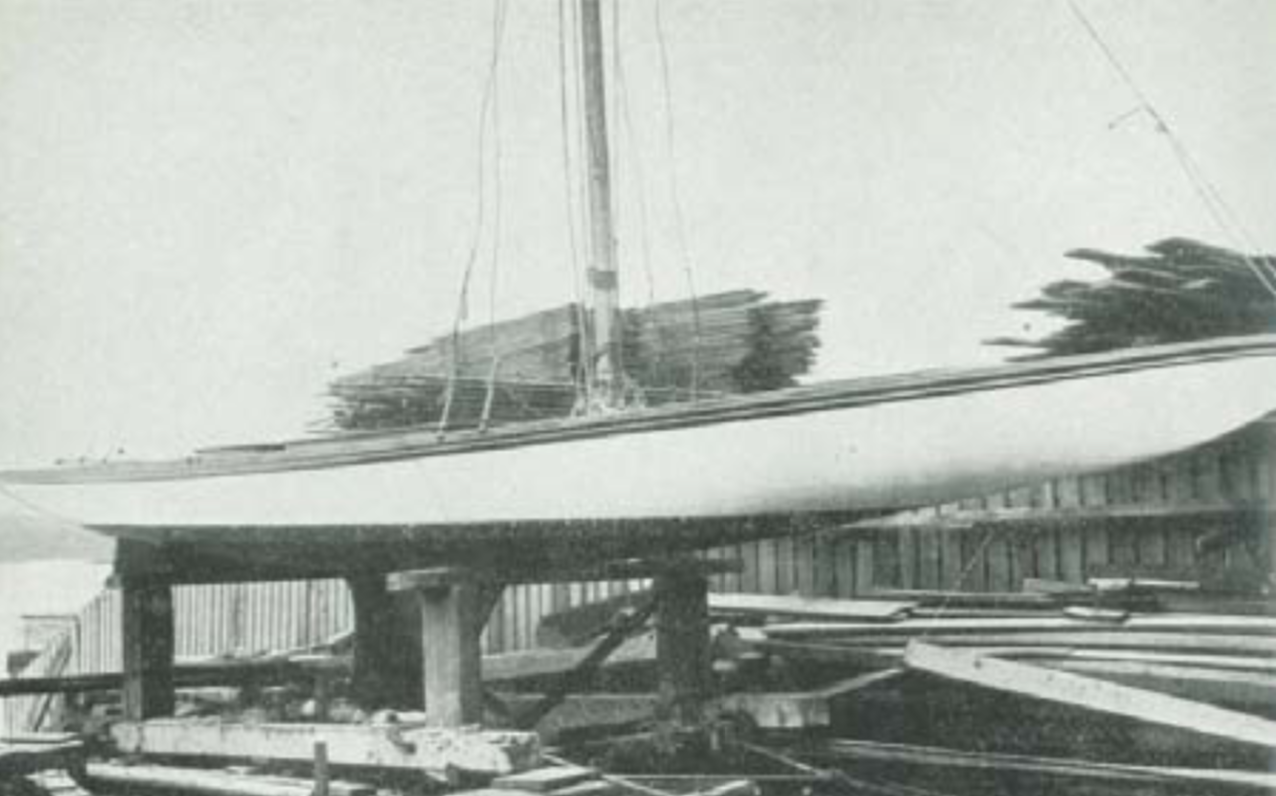 Sunbeam
Sunbeam Sunbeam (1899) is the type of boat that the linear rating system was intended to discourage. She was a radical fin and bulb racer of extreme proportions, the linear system did not penalise these designs enough.
She was sent to Sydney by Mr A. T. Pittar, and was sailed in Sydney by her builder Arch Logan, himself. She was then owned and sailed by Fred Doran to victory, in the Centenary Cup on Sydney Harbour.
1902 Sydney Fleet of 30’ Lineal Raters
Aoma C.T. Brockhoff Logan
Heather Dr G. Craig Logan
Petrel S.M. Dempster Logan
Culwulla W.M. Marks Logan
Sunbeam A.W. Crane Logan
Cooya A.W. Crane C. Bailey Jr
Janet Muston C . Bailey Jr
Meteor Dr J. Elliot C. & W. Bailey
Kukuburra A.E. Cutler A.E. Cutler
Magic J.O. Fairfax Summer & Payne
Fleetwing S. Horderm W. Fife

Logan Brothers Designer and Builder of Yeulba
The family patriarch, Robert Logan Senior, arrived in Auckland in 1874, with his wife and family. Logan was born and trained in Scotland. He quickly established a reputation as an excellent designer and boat builder with fine skills and sailing abilities. He also pioneered a unique double and triple diagonal planking construction technique for yachts that used the fine qualities of the native New Zealand kauri timber. Robert’s sons followed in the trade and matched his excellence when Robert Jnr and Arch set up Logan Bros in the early 1890s. Arch Logan was the firm’s designer, and he shared his father’s eye for proportions and the same uncanny ability to produce race winning yachts.
Very few drawings were prepared for each new design. The family-operated yard knew from experience how to interpret and proportion the structure and details to a high standard.
Although their Auckland yard lasted less than 20 years, it was the most significant yacht and boat building business in the Southern Hemisphere during its time, dominating the New Zealand market and exporting craft to Australia, South Africa and the Pacific islands. A Logan yacht is a treasure of design, construction and performance.
DAVID PAYNE
Yacht Designer
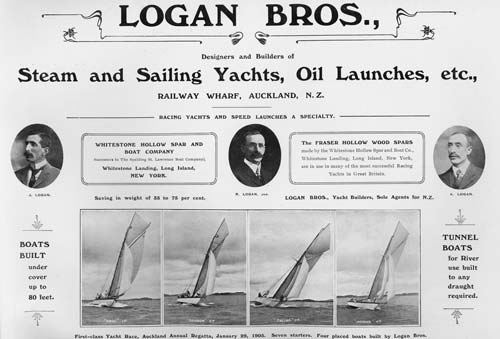
Racing Yeulba
A lifetime of sailing could be had shipping Yeulba around the world to various classic yacht regattas. Yeulba has all of the attributes to be a standout attraction at any event. Not only would she represent a wonderful, working exhibit of early Australian yachting history, she would be a fast and exciting performer.
Classic Yacht Association of Australia
The Classic Yacht Association was formed in 1994 to promote the ownership, knowledge and appreciation of classic sailing craft in Australia and to preserve them for future generations. It now has approximately 250 members and 120 boats on its register. It organises and supports sailing regattas and events in four states. Flagships of the CYA fleet include, Sayonara, Windward 11 and Acrospire. Yeulba would be a wonderful addition. At under 8’ beam she is legally road transportable in all states. With her own trailer, you could enjoy a range of regattas all over Australia.
Yeulba is well placed to compete at events around the globe such as Antigua Race Week, as well as classic yacht events in France, Spain, Isle of Wight, Italy, New Zealand & USA.
As Yeulba spent a great deal of time racing as an 8 metre yacht in the early days of the class, it may be possible to have her comply with this class for classic events. Classic 8 Meter racing is extremely popular throughout Europe.
Restorations at The Wooden Boatshop
The beginnings of The Wooden Boatshop under a carport in Portsea, driven by Tim Phillips’ passion and love for Couta Boats, soon became a thriving business fundamentally focused around the restoration of the unique Australian fishing boats. It is easy to pick the Couta Boats that have had a Tim Phillips restoration. These boats stand in perfect condition, with seamless transitions between old and new material, remaining true to their origins.
Today, at The Wooden Boatshop, it would be easy to walk through the workshops and classify the business purely as a manufacturing plant. We build as many as five new boats each year, and have near completed our 118th vessel!
We have restored hundreds of boats; from Clinker Dinghies, Riva’s, Chris Craft, Lewis and Hammond speed boats to ocean going yachts and cruisers. Two of our boats installed in museums have been meticulously restored in collaboration with conservators.
It is with this pioneering experience that we are able to offer Yeulba restored to The Wooden Boatshop standard and philosophy, of using as much of the original vessel as possible, retaining the original form and patina, and with the assistance of technology, to present Yeulba with a 1901 finish and configuration.
The finished result is only as strong as the research and information available. We have access to all of the information required to restore and configure Yeulba, true to original specifications. This aspect alone makes her a wonderful and worthy project.
If the boat is to be a working exhibit it must be user-friendly. For example, it is okay to substitute synthetics for the original linen sails, for greater longevity. Paints and adhesives of today allow for maintenance schedules on classic boats at a quarter of the cost of the old days of enamel and varnish. Ball bearing sheaves can be used in wooden shell blocks, and polyester laid rope give nothing away in appearance. The benefits of all these technological improvements are well accepted aboard classic yachts, allowing Yeulba to be very easy to maintain and a pleasure to sail.







Specifications for Yeulba
Outline Particulars
LOA: 42’6”
Beam: 7’10”
Draft: 5’
Hull
Planking: Double skin New Zealand Kauri planking (original)
Frames: Laminated floors and ring frames throughout
Fastenings: Copper and silicon bronze
Ballast: Original lead ballast keel
Gunnels: Original
Deck, coach house, hatches and cockpit
Deck beams: Some original, some new laminated Kauri
Deck boards: Laid sprung Kauri deck, fastened with silicon bronze screws, caulked and finished with oil
Coach house: Bent Kauri sides, fitted in traditional manner with laid boards over laminated beams Hatches: Configured as per original boat, 1 foredeck hatch, 1 coach house roof hatch, companionway hatch Cockpit: Self-draining cockpit with grating, benches and combings fitted
Fit Out
Kauri benches and lockers with upholstered cushions
Laid floor boards with bronze hold-downs
Rig
Type: Pole masted, gaff cutter with jackyard topsail
Mast: Sitka spruce, hollow birdsmouth construction Spars: Include gaff, boom, jackyard, topsail yard, spinnaker pole and jiboom, laminated sitka spruce Standard Rigging: Synthetic fibre, spliced, served and leathered in the traditional manner Running Rigging: White polyester laid rope, spliced and whipped to finish Blocks: Teak shell blocks with ball bearing sheaves
Hardware
Deck, rudder and rig hardware to be bronze
Painting and Varnish All exterior paintwork to comprise a minimum of two coats of epoxy primer undercoat, two coats of polyurethane gloss to colour specification. Anti-fouled below waterline. Varnish to be advised, either Sikens Cetol or Altex polyurethane is recommended. Deck to be oiled.
LOA: 42’6”
Beam: 7’10”
Draft: 5’
Hull
Planking: Double skin New Zealand Kauri planking (original)
Frames: Laminated floors and ring frames throughout
Fastenings: Copper and silicon bronze
Ballast: Original lead ballast keel
Gunnels: Original
Deck, coach house, hatches and cockpit
Deck beams: Some original, some new laminated Kauri
Deck boards: Laid sprung Kauri deck, fastened with silicon bronze screws, caulked and finished with oil
Coach house: Bent Kauri sides, fitted in traditional manner with laid boards over laminated beams Hatches: Configured as per original boat, 1 foredeck hatch, 1 coach house roof hatch, companionway hatch Cockpit: Self-draining cockpit with grating, benches and combings fitted
Fit Out
Kauri benches and lockers with upholstered cushions
Laid floor boards with bronze hold-downs
Rig
Type: Pole masted, gaff cutter with jackyard topsail
Mast: Sitka spruce, hollow birdsmouth construction Spars: Include gaff, boom, jackyard, topsail yard, spinnaker pole and jiboom, laminated sitka spruce Standard Rigging: Synthetic fibre, spliced, served and leathered in the traditional manner Running Rigging: White polyester laid rope, spliced and whipped to finish Blocks: Teak shell blocks with ball bearing sheaves
Hardware
Deck, rudder and rig hardware to be bronze
Painting and Varnish All exterior paintwork to comprise a minimum of two coats of epoxy primer undercoat, two coats of polyurethane gloss to colour specification. Anti-fouled below waterline. Varnish to be advised, either Sikens Cetol or Altex polyurethane is recommended. Deck to be oiled.

